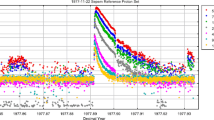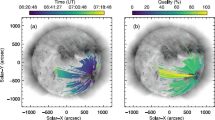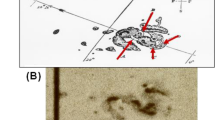Abstract
Time profile of the fluxes of energetic solar particles generated by solar flares (including their phase of decline) is formed to a large extent by the structure of the interplanetary magnetic field and its irregularities that move away from the Sun with the solar wind velocity. When propagation is a pure diffusion, the solar particle fluxes decay after the maximum in a power-law manner. At the same time in many cases this decay is exponential, which is indicative of a considerable role played by the convective sweep of particles and their adiabatic deceleration in the expanding solar wind. In this paper we consider the events with long exponential decays and newly discovered series of successive events with identical exponential decays lasting for one to two weeks or more. They allow us to assume that the interplanetary space is stable and homogeneous during this period.
Similar content being viewed by others
REFERENCES
Bartley, W.C., Bukata, R.P., McCracken, K.G., and Rao, U.R., Anisotropic Cosmic Radiation Fluxes of Solar Origin, J. Geophys. Res., 1966, vol. 71, p. 3297.
McCracken, K.G. and Ness, N.F., The Collimation of Cosmic Rays by the Interplanetary Magnetic Field, J. Geophys. Res., 1966, vol. 71, p. 3315.
McCracken, K.G., Ray, U.R., Bukata, R.P., and Keath, E.P., The Decay Phase of Solar Flare Events, Solar Physics, 1971, vol. 18, p. 100.
Morozova, E.I., Pisarenko, N.F., Kurt, V.G., et al., Generation and Propagation of Charged Particles in the Solar Events of 22 July, 1972, Space Research, 1976, vol. 16, p. 775.
Forman, M.A., The Equilibrium Anisotropy in the Flux of 10-MeV Solar Flare Particles and Their Convection in Solar Wind, J. Geophys. Res., 1970, vol. 75, p. 3147.
Jokipii, J.R., Propagation of Solar Cosmic Rays in the Solar Wind, in Solar Activity Observations and Predictions, McIntosh, P.S. and Dryer, M., Eds., MIT Press, 1972.
Daibog, E.I., Keiler, S., Kechkemeti, K., and Logachev, Yu.I., Statistical Characteristics of Decays of Particle Fluxes in Solar Proton Events over a Long Period (1974-2001), Izv. Ross. Akad. Nauk, Ser. Fiz.,2003, vol. 67, p. 482.
Lee, M.A., Acceleration of Energetic Particles on the Sun, in the Heliosphere, and in the Galaxy, Acceleration and Transport of Energetic Particles Observed in the Heliosphere, Proc. AIP Conf., 2001, vol. 528, p. 3.
Vernov, S.N., Grigorov, N.L., Likin, O.B., et al., Cosmic Ray Studies onboard the PrognozSatellites, Izv. Akad. Nauk SSSR, Ser. Fiz., 1973, vol. 37, p. 1138.
Van Hollebeke, M.A., Wang, J.R., and McDonald, F.B., A Catalogue of Solar Cosmic Ray Events,X-661-74-27, NASA GSFC, 1974.
Kallenrode, M.-B., Neutral Lines and Azimuthal “Transport” of Solar Energetic Particles, J. Geophys. Res., 1993, vol. 98, p. 5573.
Kahler, S.W., Kunches, J.M., and Smith, D.F., Role of Current Sheets in the Modulation of Solar Energetic Particle Events, J. Geophys. Res., 1996, vol. 101, p. 24383.
Rights and permissions
About this article
Cite this article
Daibog, E.I., Logachev, Y.I., Kahler, S.W. et al. Sequences of Solar Events with Identical Decays as a Tool for Isolating Quasistationary States in the Interplanetary Space. Cosmic Research 42, 362–369 (2004). https://doi.org/10.1023/B:COSM.0000039735.35134.70
Issue Date:
DOI: https://doi.org/10.1023/B:COSM.0000039735.35134.70




